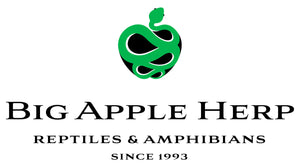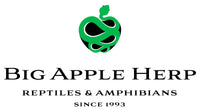Care Sheet For Red Tail Boas
Red Tail Boas have been a favorite of snake keepers for many years, but as responsible boa breeders we want to give you all the facts you'll need to make a proper decision on owning these wonderful animals. Red Tail Boas are truly magnificent snakes, but the cute, 3-ounce, 20-inch hatchling will grow to a whopping 4-to-5 feet within a year. By the end of the second year the Red Tail Boa will typically reach 6 to 10 feet total. After the second year growth rate slows significantly and an adult size of 6 to 10 feet will take place. Red Tail Boas typically live a long time and while captive bred Red Tails are docile snakes that adapt to handling well you need to consistently handle your snake to keep it that way. At Big Apple Pet Supply, we carry only Captive Bred Red Tail Boas to maintain strict quality control. Wild caught Red Tail Boas typically carry parasites and can be much more aggressive than captive bred.
Housing
Baby and Juvenile Red Tail Boas can be set up in an enclosure as small as a 20 gallon (30" x 12" x 12"H) but within a year will require much larger housing. Adults will end up needing an enclosure that is either 6' x 2' x 2'H or 4' x 2' x 4'H. There is no such thing as a cage too big for a Red Tail Boa so larger is always better especially if you provide some climbing room since Red Tail Boas are very happy to climb and hang out off of the ground. Since like most snakes, Red Tail Boas are escape artists, a secure screen top is absolutely critical to keep your snake from escaping the enclosure.
Substrate
We particularly like the Zoo Med Forest Floor Cypress Bedding or Zoo Med Eco Earth for use with Red Tail Boas. Zoo Med Aspen Snake Bedding is another possible substrate for Red Tail Boas and many enjoy using it. It is recommended to stick to well-known substrates that are designed for use with reptiles. If you use commercial brands of Aspen or Cypress bedding please be careful as they may contain a high amount of dust or other contaminants that can be harmful. Baby Red Tail Boas can also be kept on paper towels or similar product until they become juveniles.
Heating
As with all reptiles, Red Tail Boas need a thermal gradient consisting of a warm side (90° F) and a cool side (80° F). The best way to heat your Red Tail Boa's enclosure is with a combination of a heat mat and ceramic heat emitter. We recommend the Intellitemp Heat Mat and Big Apple Black Heat Infrared Ceramic Heat Emitter. The heat mat and ceramic heat emitter should be located on one side while the other side should not have any heat source. We recommend controlling the ceramic emitter with a thermostat, such as the BAH-500 or BAH-1000DC, and monitoring the temperatures with a thermometer.
Lighting
Red Tail Boas, like all snakes do not require a light or UV bulb. If you choose to add a basking bulb to add more light to your cage make sure that you maintain proper heat levels but not go over 92° F as this could be detrimental to your snake's health
Shelter
It is essential to the well-being of your Red Tail Boas to have hiding places in their enclosure. The shelter can be anything from a Big Apple Basic Reptile Hide Box to a decorative reptile shelter, hiding hut or cave. It is always a good idea to have one shelter on the warm side and one on the cool side. If you choose to make a hiding place yourself, please make sure it is sturdy enough that there is no potential for collapsing and crushing your snake.
Shedding
Like all reptiles and amphibians, Red Tail Boas shed their entire skin all at once. Babies shed more often than adults because as babies they outgrow their skin faster. You'll note shedding time when your snake's eyes turn a shade of blue and become cloudy.
Snakes normally shed their skin easily but sometimes they have issues if they do not have the proper humidity while shedding. For this reason, it is important to maintain a decent amount of humidity in the cage by misting a couple times a day. This is especially true around shedding time. Providing a moist shelter is another way to ensure necessary humidity during shedding. Use moistened Big Apple Imported Premium Grade Sphagnum Moss or Zoo Med Forest Floor Cypress inside your snake’s hide.
You need to check your snake after it has shed to make sure it was able to peel all the skin off, especially around the eyes. If unshed skin is not removed promptly serious health issues can form. If your Red Tail Boa has retained skin after shedding you can place the snake in a plastic container lined with warm, wet paper towels with the container lid on or soak the snake in warm water. Let the snake stay in the container or warm water for approximately 30 minutes. The high humidity in the container or using the soaking method should loosen the skin enough to allow you to remove it easily with a pair of tweezers. If the skin has not loosened enough, reheat the paper towels with warm water and provide another 30 minute session. NEVER use hot water as this can burn your Red Tail Boa.
Water
It is essential that you provide your Red Tail Boa with a large water bowl. The bowl should be large enough that the Red Tail Boa can soak its entire body in but not so big that it might have a difficult time getting in or out of the bowl. Place the water dish on the cool side of the cage so that it does not evaporate quickly.
Food
Red Tail Boas eat mice, rats and eventually even rabbits but the size of the prey is dependent upon the girth of the snake. You should not feed your Red Tail Boa anything bigger than the thickest part of its body. The prey item should leave a readily noticeable lump in the snake. This is fairly standard for all species of snakes. Hatchling snakes are typically fed every 5 days while adults are typically fed every 10 days. However, it should be noted that some hobbyists feed adult snakes once a week.
Feeding live or pre-killed has been a question we are often asked. Opinions vary on this subject but we are emphatic that thawed frozen rodents are a much better option. First, feeding thawed rodents is easier and secondly it's substantially less expensive because you can purchase rats or mice in bulk and then store them in the freezer. More importantly, it is significantly safer for the snake. The bottom line is that a thawed mouse will never bite or chew on your snake in defense. We have seen nasty rodent bites inflicted on snakes when fed live rodents. We suggest you play it smart and go with feeding thawed prey items. At Big Apple Pet Supply, we carry a huge selection of frozen feeders that we deliver right to your door.
Vitamins
It is important to feed high quality rodents to your snake and it is always a good idea to coat the rodent with a bit of vitamin and calcium powders before feeding them. We carry a full line of quality reptile vitamins and calcium.
Cage Maintenance
Red Tail Boas require minimal maintenance as they usually excrete small amounts of semi-solid fluid. Aspen and similar substrates allow for quick cleaning of feces and using one of our scoopers (for sale in our cleaning section) you can perform this task when defecation occurs. The bedding should be completely thrown out and the entire cage (including all accessories) should be washed with Quat Plus (available in our cleaning section) or a mild detergent at least once every four to five months. If using paper towels, change all paper towels at least once a week.
Hibernation
Hibernation is not natural for Red Tail Boas so make sure you heat your Red Tail Boas throughout the winter so that they continue to eat, drink and be active. A general reduction in feeding behavior is normal during winter months due to temperature fluctuations in your house. As long as they keep fairly consistent weight it is generally not an issue and normal feeding typically resume in the spring.


